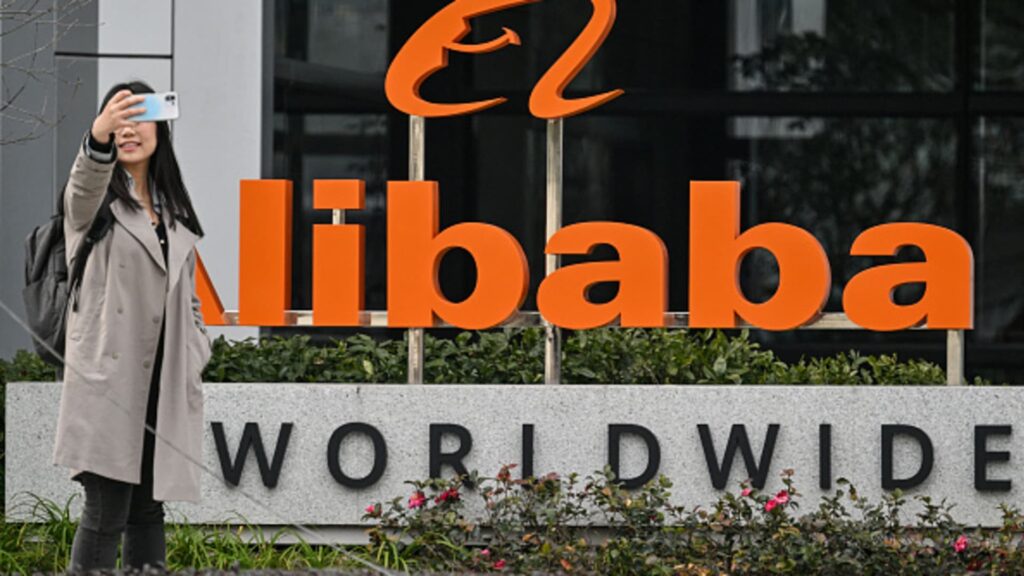A woman poses for a selfie next to signage for e-commerce giant Alibaba in the Xuhui district in Shanghai on Feb. 22, 2025.
Hector Retamal | Afp | Getty Images
Alibaba and ByteDance’s TikTok Shop are just some of the Chinese e-commerce players that have quickly come to dominate around half of the online shopping market in several Southeast Asian countries, consulting firm Bain and Company said in a report Thursday.
In Indonesia, Thailand and the Philippines, Chinese online shopping players — such as Shein and PDD‘s Temu — account for roughly 50% of the local e-commerce market, data for 2024 showed, according to the report. It indicated the Chinese companies have also gained a foothold in the growing online commerce market in countries from the U.S. to Brazil.
The findings come as Chinese companies are accelerating their global expansion, amid slowing economic growth at home — and despite escalating U.S.-China trade tensions.
“Far from being killed by tariffs, the internationalization of Chinese retail is entering a new phase,” the report said. Its authors noted that the Chinese sellers have so far tended to perform better “in markets with lower online purchasing power.”
This year, Bain pointed out, Alibaba’s Taobao is expanding Singles Day shopping promotions to 20 regions — meaning the world’s biggest shopping event is no longer just a factor for China but markets where rival Amazon.com has pushed its Black Friday sales.
It’s not immediately clear the extent to which Singles Day was promoted outside China in past years. But the ramp up is recent. Taobao in Malaysia last year announced it would be the first time the shopping event would be promoted in English, in addition to Chinese.
Alibaba’s international division — called “International Digital Commerce Group” — reported 19% year-on-year revenue growth in the three months ended June 30 to 34.74 billion yuan ($4.85 billion).
That was slightly more than what the company’s cloud computing unit brought in, but still far less than the 140.07 billion yuan in revenue generated by Alibaba’s China e-commerce business, which saw slower growth at 10%. Similar to Amazon.com, merchants open accounts on Alibaba’s platforms to sell directly to consumers.
One signal of how quickly Chinese sellers are expanding their online sales abroad comes from financing numbers.
In just over a year, fintech startup FundPark has facilitated $3 billion in loans to small Chinese businesses for overseas e-commerce — it had previously taken the company six years to lend the same $3 billion amount, Anson Suen, co-founder and CEO, told CNBC.
FundPark, which has received $750 million in financing from Goldman Sachs and HSBC, assesses how much small merchants can borrow by using its tech-based data analysis. The startup on Tuesday announced it raised $71 million to support its new artificial intelligence-powered tool for “dynamic funding” that can help merchants navigate tariff uncertainties.
Taking China learnings abroad
Part of the Chinese e-commerce companies’ success comes from lessons learned in their home market that integrate livestreaming, rapid product innovation and speedy logistics, Bain analysts pointed out.
In fact, Amazon shut down its China marketplace in 2019 amid rising competition from domestic players.
The country’s giant market has provided fertile training ground.
At $2.32 billion in gross merchandise value sold last year, the Chinese e-commerce market is more than twice the size of the U.S., which saw $1.05 billion in GMV last year, Bain said. GMV is a measure of sales on an ecommerce platform over a period of time.
In Southeast Asia, Indonesia was the largest market with $62 billion in e-commerce GMV last year, while Thailand and Vietnam each recorded $30 billion in GMV, Bain said. The Philippines saw $20 billion in 2024 GMV, while Singapore’s was far smaller at just $8.55 billion.
But it’s far from a straight path to growth for Chinese players in every market.
Bain pointed out that in Singapore, Alibaba’s Lazada had lost market share to the local incumbent Shopee, while Amazon and Walmart still dominate in the U.S.
While PDD, Alibaba and ByteDance divide up most of the Chinese market, the U.S. is a far different story, with Bain data showing that non-Chinese e-commerce players accounted for nearly 95% of the market.
The U.S. e-commerce giants also have a large international presence.
Amazon reported net sales in North America of $100.1 billion in the quarter ended June 30, while international sales were $36.76 billion, meaning the U.S. e-commerce giant still makes more in net sales than Alibaba at home and abroad. The U.S.-based e-commerce giant is set to report earnings Thursday local time.
Walmart reported $23.7 billion in online U.S. sales in the quarter ended July 31, and $8.3 billion overseas — up 22% from a year ago, according to CNBC calculations.
— CNBC’s Victoria Yeo contributed to this report.
(Source)


